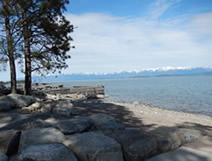Lakeshore Protection Zone
The lake and lakeshore protection zone is defined as, the land area which is located within 20 horizontal feet of the perimeter of the lake, including adjacent wetlands, when the lake is at the mean annual high water elevation.
Purpose of the Lake and Lakeshore Protection Regulations
|
 |
When is a Permit Required
When any work on, and/or disturbance of a lake, lakebed, or lakeshore protection zone requires the issuance of a Lake and Lakeshore Construction Permit prior to commencement of work. Some exceptions exist to enable general maintenance and minor repairs to structures and shorelines, using hand tools and meeting certain limitations.
Prevent the Intorduction of Aquatic Species
Any used structure (dock, buoy, shore station, etc.) should be inspected and disinfected prior to installation within the Lake and Lakeshore Protection Zone to prevent the introduction of aquatic invasive species into Flathead County lakes.
Species of Concern may attach to used structures and harm Montana lakes if introduced, they include:
- Zebra Mussels
- Quagga Mussels
- Fishhook Waterflea
- Spiny Waterflea
- Algae, including:
- Didymosphenia geminata
- Eurasian filamentous algae
- Harmful algal bloom–forming cyanobacteria (e.g., Microcystis, Anabaena)
Be sure to inspect all areas of the structure for visible algae, plant matter, and aquatic organisms. Remove all visible debris using scrub brushes or high-pressure washer and avoid draining any water near storm drains or lakeshores. To disinfect wash thoroughly with hot water at 140°F (60°C) for at least 10 minutes, soak or spray with a bleach solution (10%) OR full-strength white vinegar (do not mix bleach and vinegar), rinsed thoroughly, and leave the structure to dry completely for at least 7 consecutive days in warm temperatures (longer if cool/humid).